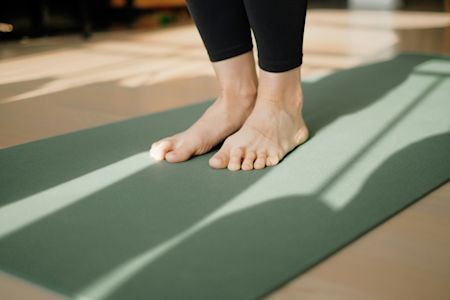“After a month, I’d lost half a stone and my pain lessened”
One year on The Body Coach app – and how it changed this woman's life.
Sign up for an annual subscription to The Body Coach app for just £69.99 (usually £89.99)

Pilates is having a moment. What used to be seen as a niche workout has totally taken off – and people are loving it.
This isn’t just in the UK, but all over the world. Pilates was the most‑booked workout globally in 2024, with ClassPass bookings jumping by 84% compared to the year before. And Pilates fitness classes are on the up, too – wall Pilates was named the ‘top trend’ of 2024 by PureGym.
So why now? Why’s the world favouring a workout that has been around since the 1920s? We spoke to Julie Clifton, a Pilates teacher from the Pilates Foundation to find out more.
[READ MORE: A Beginner's Guide to Pilates]
Joseph Pilates invented this method in the 1920s, and called it Contrology, explains Julie. “It was all about using your mind to control your body,” she says. “It wasn’t a cardiovascular workout, it was about learning to use your body better.”
In the 1970s, a man called Alan Herdman brought Pilates to the UK after studying it in New York – he set up Britain’s first-ever Pilates studio.
In those early years of Pilates, “you could trace the lineage of all classes back to Joseph Pilates,” explains Julie. For Joseph, Pilates was mat work, with 34 classic exercises that were key to the method. He had equipment in his studios – the reformer and Cadillac, for example – but this was his rehabilitation equipment for people not strong enough to do mat work.
In the 1990s, Body Control Pilates was introduced in the UK by Lynne Robinson and Gordon Thomson. Lynne wanted to make Pilates more accessible for the general population, not just dancers or athletes. Her style was mat-based Pilates for accessibility.
In the late 1990s, a legal attempt was made to trademark the term ‘Pilates’, but a US judge ruled that it had become a “generic term” and a trademark couldn’t be enforced. Essentially, that opened up Pilates to become free and available for anyone to teach, which some say led to the explosion of diverse Pilates classes. And it’s true, many Pilates fitness classes couldn’t have expanded without that ruling.
“Since then, Pilates has been used in such a wide way,” explains Julie. “Now, you can’t always trace back the work to Joseph Pilates – despite it being similar in some way.
“In the last 10 years, there has been a real resurgence. The whole method has changed quite significantly and certain parts of the studio equipment – reformer, for example – have become popular.”
Ultimately, Pilates is an unregulated term, so as time has gone on, it isn’t surprising that the link back to Joseph Pilates has, for some people teaching fitness classes, been diluted.
Now, EMD UK (a government body for group exercise) has differentiated between ‘Pilates Method’ (based in a studio, teaching Joseph Pilates’ method of the core exercises) and ‘Fitness Pilates’, which is inspired by the Pilates method and is usually delivered in a fitness/group exercise setting.
Pilates fitness classes have evolved massively over the past 15 years because of the freedom and creativity that has been allowed. Many of these classes offer new ways to move and build strength – something that’s exciting for those looking for something a little different. There’s Reformer Pilates, Wall Pilates, Hot Pilates, and HIIT-Pilates hybrids. Reformer Pilates in particular is pretty popular – part of the appeal of this, and other new classes, is that they seem “different and quite cool”, says Julie.
These are very different to Pilates method classes, explains Julie. “Class sizes are much smaller for most method teachers and there is more emphasis on teaching people to do exercises tailored to their specific needs,” she explains.
There’s also a big focus on wellbeing that aligns with Pilates’ boost in popularity. Unlike fast-paced workouts, Pilates emphasises breath and control, which can help reduce anxiety and boost body awareness. “You’re concentrating on using your body well,” says Julie. “When you really focus on your movement, you’re in a state of mindfulness – people find that uplifting. It gives you a moment to focus on yourself.”
Recent studies are sharing the benefits of these classes, too, which people are becoming more aware of. A 2023 study found that Pilates can improve balance, muscular endurance, and reduce lower back pain, and another found a reduction in depression and anxiety.
The low-impact nature of Pilates is a big draw, helping people build strength without putting stress on their joints – something more of us are looking for. And with creative twists on Pilates classes becoming more widespread, there’s loads of variety to keep people interested.
This article was written by The Body Coach content team.